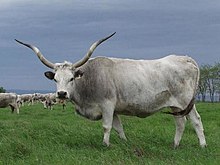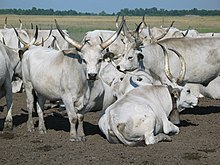The Hungarian Grey (Hungarian: Magyar Szürke, pronounced [ˈmɒɟɒr ˈsyrkɛ] ⓘ), also known as the Hungarian Grey Steppe,[5]: 334 is a Hungarian breed of beef cattle.[4][6]: 96 It belongs to the group of Podolic cattle[7]: 27 [8]: 49 and is characterised by long lyre-shaped horns and a pale grey coat. It is well adapted to extensive pasture systems and was formerly raised in very large numbers in the Hungarian puszta. In the twentieth century it came close to extinction, but numbers have since risen.
 In the Mekszikópuszta in western Hungary | |
| Conservation status | |
|---|---|
| Other names |
|
| Country of origin | Hungary |
| Distribution | |
| Use | dual-purpose, draught and beef |
| Traits | |
| Weight | |
| Height | |
| Skin colour | slate-coloured, dark grey mucosa |
| Coat | shades of grey, from silvery white to ash grey |
| Horn status | long slender horns, round in cross-section |
| |

History
editThe origins of the Hungarian Grey are unknown. It was formerly accepted that it had arrived in the ninth century with the Magyars who came from the east, took the Carpathian Basin and settled there; this theory is not consistent with the archaeological record.[7]: 9 It has also been suggested at various times that it was introduced in some later migration, possibly by Cumanian or Pecheneg peoples; that it was brought from the south by refugees from the Balkans;[7]: 10 or that it came from the Italian peninsula, acquired either by raiding in the tenth century, or by trade during the period of Angevin rule in the fourteenth century.[8]: 50 Another theory, that it descends directly from the aurochs, Bos primigenius, was attributed by Charles Darwin, writing in 1868, to Ludwig Rütimeyer;[9]: 80 [10]: 13 it is not consistent with the osteometric data, but the possibility remains of some aurochs influence in Mediaeval times.[8]: 50
From the Middle Ages until the eighteenth century great numbers of grey cattle were raised extensively on the plains of Hungary. Many were driven on the hoof by hajduk for hundreds of kilometres westward to the markets of cities in western Europe to be slaughtered for beef.[7]: 11 [11]: 26 The principal destination was Vienna, but others reached Augsburg, Auspitz, Nürnberg, Strasbourg and Venice.[7]: 11 [8]: 50 During the fifteenth and sixteenth centuries, tens of thousands of cattle were exported in this way each year, and in the seventeenth century the number may have exceeded 100,000 per year.[7]: 11 [12]: 718 The trade was gravely disrupted by the Ottoman invasions, and for some time was also limited by a monopoly granted by the Imperial court to the Landverleger-Compagnia of Vienna in 1622.[7]: 11 [12]: 718
Hungarian cattle are documented at Augsburg in a document of 1526.[13]: 198 Another sixteenth-century document refers specifically to magnus cornuotes boves Hungaricos or 'long-horned Hungarian cattle'.[14]: 1786
In the eighteenth century changing market conditions led to a substantial decline in this trade, and the cattle came to be used principally as draught animals, a purpose to which they were well suited.[7]: 12
In 1931 the Hungarian Grey Cattle Breeders' Association was established and encouraged the keeping and breeding of the cattle.[6]: 96 World War II disrupted the efforts.[6]: 96 There were only 160 cows and 6 bulls on three farms in the early 1960s.[6]: 96 Around that time a patriotic interest in preserving local breeds emerged.[6]: 96
By 1975 there were only 300 cows left in two herds, but numbers have since increased. The rebound in numbers is partially due to cryoconservation efforts made by the Hungarian government.[15] Government subsidies are available to breeders of the cattle.[16]: 55 In 2003 the Hungarian Grey supplied approximately 12% of the locally-produced beef consumed in Hungary.[16]: 9 It is distributed mainly in the counties of Bács-Kiskun, Hajdú-Bihar and Veszprém.[17]
Characteristics
editHungarian Grey cattle are robust,[11]: 26 slender and tall. They have high muscle content and marbled meat. Bulls stand about 150 cm at the withers, and weigh some 800 kg; cows average 135 cm in height and 525 kg in weight.[2]
The coat colour ranges from silvery-white to ash-grey; males are usually darker than cows, with a black scrotum and eyes ringed with black.[18]: 203 [19] The skin is pigmented and grey.[19] As in other Podolic breeds, the calves are born reddish and become grey at about six months old.[8]: 51 [18]: 203 The horns are long and curved and are directed upwards in a lyre shape;[18]: 203 they may be some 70 to 80 cm in length.[19]
The Hungarian Grey shares with indicine cattle some genetic characteristics relating to milk proteins including casein, and to amplified fragment length polymorphism marker haplotypes. It does not otherwise show any marked similarity to zebuine cattle.[18]: 203
Use
editThe Hungarian Grey is reared for beef. It is slow to develop, but the meat is low in fat and is suitable for the manufacture of beef salami and beef sausages.[17] It is included in the Ark of Taste of the international Slow Food Foundation.[17]
Herds of the cattle function as a tourist attraction in the Hortobágy National Park and other Hungarian national parks. Some may be found elsewhere, such as in Bocfölde in western Hungary. These herds serve as gene banks, due to their reported resistance to cattle diseases which affect more highly bred cattle types.[citation needed]
See also
editReferences
edit- ^ Barbara Rischkowsky, Dafydd Pilling (editors) (2007). List of breeds documented in the Global Databank for Animal Genetic Resources, annex to The State of the World's Animal Genetic Resources for Food and Agriculture. Rome: Commission on Genetic Resources for Food and Agriculture, Food and Agriculture Organization of the United Nations. ISBN 9789251057629. Archived 23 June 2020.
- ^ a b Breed data sheet: Magyar Szürke / Hungary (Cattle). Domestic Animal Diversity Information System of the Food and Agriculture Organization of the United Nations. Accessed January 2022.
- ^ Zootierliste (undated): "Hungarian grey cattle (Hungarian Steppe cattle)."
- ^ a b c d e Breed data sheet: Magyar Szürke/Hungary. Domestic Animal Diversity Information System of the Food and Agriculture Organization of the United Nations. Accessed May 2014.
- ^ Marleen Felius (1995). Cattle Breeds: An Encyclopedia. Doetinchem, Netherlands: Misset. ISBN 9789054390176.
- ^ a b c d e Barbara Rischkowsky, Dafydd Pilling (editors) (2007). The State of the World's Animal Genetic Resources for Food and Agriculture. Rome: Commission on Genetic Resources for Food and Agriculture, Food and Agriculture Organization of the United Nations. ISBN 9789251057629. Archived 10 January 2017.
- ^ a b c d e f g h Imre Bodó, István Gera, Gábor Koppány, trans. Béla Borsos (2004). The Hungarian Grey Cattle Breed. Budapest: Magyar Szürke Szarvasmarhát Tenyésztôk Egyesülete.
- ^ a b c d e László Bartosiewicz (1997). The Hungarian Grey cattle: a traditional European breed. Animal Genetic Resources Information (21): 49–60.
- ^ Charles Darwin (1868). The Variation of Animals and Plants Under Domestication, volume I. London: John Murray.
- ^ Ludwig Rütimeyer (1866). Über Art und Raçe des zahmen europäischen Rindes (in German). Braunschweig: [publisher unknown]. Cited in: Charles Darwin (1868). The Variation of Animals and Plants Under Domestication, volume I. London: John Murray.
- ^ a b Anikó Gergely, Ruprecht Stempell, Christoph Büschel, Mo Croasdale (2008). Culinaria Hungary. Potsdam, Germany: H.F. Ullmann. ISBN 9783833149962. OCLC 566879902.
- ^ a b Marleen Felius, Marie-Louise Beerling, David S. Buchanan, Bert Theunissen, Peter A. Koolmees and Johannes A. Lenstra (2014). On the History of Cattle Genetic Resources. Diversity 6 (4): 705–750. doi:10.3390/d6040705
- ^ László Bartosiewicz (2017). Hungarian Grey Cattle: Parallels in Constituting Animal and Human Identities. In: Sarah Cockram, Andrew Wells (editors) (2017). Interspecies Interactions: Animals and Humans between the Middle Ages and Modernity. Abingdon, Oxfordshire: RoutledgeISBN 9781351612630.
- ^ A. Zsolnai, Á. Maróti-Agóts, A. Kovács, A.V. Bâlteanu, E. Kaltenecker, I. Anton (2020). Genetic position of Hungarian Grey among European cattle and identification of breed-specific markers. Animal. 14 (9): 1786–1792. doi:10.1017/S1751731120000634.
- ^ L. Solti, E.G. Crichton, N.M. Loskutoff, S.Cseh (2000). Economical and Ecological Importance of Indigenous Livestock and the Application of Assisted Reproduction to Their Preservation. Theriogenology. 53 (1): 149–62. doi:10.1016/S0093-691X(99)00248-4. (subscription required).
- ^ a b Mihály Pásztor (editor) (2003). First Country Report on Animal Genetic Resources: Republic of Hungary. Budapest: Ministry of Agriculture and Rural Development. Annex to: Barbara Rischkowsky, Dafydd Pilling (editors) (2007). The State of the World's Animal Genetic Resources for Food and Agriculture. Rome: Commission on Genetic Resources for Food and Agriculture, Food and Agriculture Organization of the United Nations. ISBN 9789251057629. Archived 10 January 2017.
- ^ a b c Razza bovina grigia ungherese: Arca del Gusto (in Italian). Bra, Cuneo: Fondazione Slow Food per la Biodiversità Onlus/Slow Food Foundation for Biodiversity. Archived 25 June 2024.
- ^ a b c d Valerie Porter, Lawrence Alderson, Stephen J.G. Hall, D. Phillip Sponenberg (2016). Mason's World Encyclopedia of Livestock Breeds and Breeding (sixth edition). Wallingford: CABI. ISBN 9781780647944.
- ^ a b c Breed description: Hungarian Grey. Department of Animal Breeding and Genetics, School of Veterinary Medicine Hannover. Archived 15 October 2007.
Further reading
edit- Bodó Imre (1994). Magyar szürke szarvasmarha (in Hungarian). Debrecen: Hortobágyi Nemzeti Park Igazgatóság.
- Bellon Tibor, Kútvölgyi Mihály (2001). A magyar szürkemarha (in Hungarian). Budapest: Timp. ISBN 9789630077613
- Borics Imre (2006). Magyar szürke tenyésztése, tejtermelése és keresztezése Hosszúháton (in Hungarian). Debrecen: Hortobágyi Természetvédelmi és Génmegőrző Kht.; Magyar Szürke Szarvasmarhát Tenyésztők Egyesülete. ISBN 9789630609937
- Károlyi Zsuzsanna, Székely Sándor (2010). Magyar szürke szarvasmarha: Folyóiratcikkek és szakkönyvek ajánló bibliográfiája a Magyar Mezőgazdasági Bibliográfia alapjánaz Országos Mezőgazdasági Könyvtár állományából (bibliography, in Hungarian). Budapest: Országos Mezőgazdasági Könyvtár és Dokumentációs Központ.
- Andrea Mária Kırösi (2014). The Issue of the appearance and development of the Hungarian Grey Cattle in the Carpathian Basin based on archeozoological artifacts (doctoral thesis). Szeged: University of Szeged.